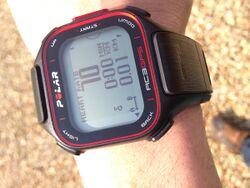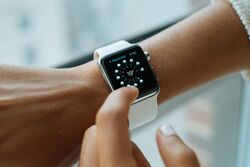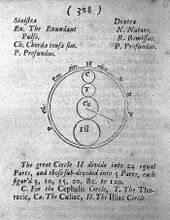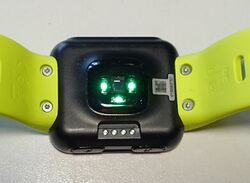Engineering:Pulse watch
 Polar RC3 GPS heart rate monitor watch | |
| Subdivisions | Heart Rate Watch |
|---|---|
| Specialist | Medical Technology |
| Glossary | Medicine |
A pulse watch, also known as a pulsometer or pulsograph,[1] is an individual monitoring and measuring device with the ability to measure heart or pulse rate. Detection can occur in real time or can be saved and stored for later review. The pulse watch measures electrocardiography (ECG or EKG) data while the user is performing tasks, whether it be simple daily tasks or intense physical activity. The pulse watch functions without the use of wires and multiple sensors. This makes it useful in health and medical settings where wires and sensors may be an inconvenience. Use of the device is also common in sport and exercise environments where individuals are required to measure and monitor their biometric data.[2]
History
In the 17th century, physicians would diagnose diseases by observing external features like breathing patterns, feeling pulse and indications of pain and fevers.[3]
The pulse watch was first made commercially available in 1701 by Sir John Floyer, who was an English physician. Floyer wanted to develop a watch to measure the accurate pulse rates of his patients. Floyer created a watch that counted a user's heart beat for sixty seconds, it created an easier way to count and measure the heart rate of patients. Floyers' designs were physically made by Samuel Watson, who was involved in horology in the late seventeenth century.[4]
From this point onwards, physicians started to make medical observations based on the number of heart beats in a minute (bpm). The functions and mechanisms of the pulse watch were updated and redeveloped by many professionals throughout history.[5] The use of pulse detecting devices have been implemented consistently by medical schools and facilities, as a form of medical technology, to accurately time the pulse and respiration of patients.
Since its commercial availability in 1707, the pulse watch gained the interest of many medical professionals. In the early 1920s, manufacturers from Switzerland incorporated scales, to improve the speed, accuracy and reliability of the device measuring a patient's pulse.[6] Today, there is greater interest in smartwatch wearable devices due to their ability to perform many other biometric and technological functions aside from measuring pulse.[7] Despite this, brands like Longines, Blancpain, Montblanc, and Vacheron Constantin still produce traditional pulse watches.[6]
Functions and mechanisms
A typical pulse watch device will use photoplethysmography (PPG), this methodology uses light and optical detectors to measure heart rate. Light emitting diodes (LEDs) and photodiodes, which are sensitive to light, measuring changes in light absorption in the body.[8]
The four main technical mechanisms of pulse watches, used to measure heart rate include:[9]
1. Optical emitters — LEDs send coloured light waves into the skin. Due to the differences in users skin colour and thickness most modern pulse watches will include multiple light waves of different lengths to interact with different skin tones and thickness.
2. Processors — the processor of the pulse watch device will capture the light that is refracted from the user's device and will translate that into a binary code. This code is then transformed into meaningful pulse rate data.
3. Accelerometer — an accelerometer can measure any motion that is used in combination with the other mentioned components, providing motion and location sensing heart rate data via an algorithm
4. Algorithms — an algorithm is formed from the processor and the accelerometer into biometric data. Data such as blood pressure and calorie intake can also be provided to the user.
The device will measure the amount of blood that is flowing through the wrist at any chosen point in time by the user. Due to blood being red in colour, red light will be reflected by the body, and green light will be absorbed. A processor then transforms this light information into biometric data to be analysed by the user.[10]
Accuracy
There have been concerns by users of the device measuring their heart rate at a consistent and continuous level, especially when in excessively motion.[11] Many studies have assessed the accuracy levels of these wearable devices to measure and monitor heart rate and have found these devices to provide valid results to users.[12][13] In one study 50 volunteers aged 18–32, continuously walked and ran on a treadmill for 30 minutes. Each participant manually checked their heart rate at each minute of the study. Results from the study show the pulse watch, reported some errors but still had a 95% accuracy level according to the study's analytical criteria.[12] In another study, 25 participants engaged in different forms of physical activity; from standing to running. The study shows that the pulse watch device accurately detected the heart rate of users while standing, walking and jogging but produced some failures when the body was excessive motion during the running activities.[13]
Types of monitoring devices
Wearable technologies that monitor heart rate has interested users for a very long time.[14] In addition to the pulse watch which monitors heart rate from pulse detection at the wrist. There are also devices which use similar technologies to monitor heart rate from the ear, forearm and chest, using a chest strap.[2] All of which still use similar mechanisms to provide unobstructed biometric data for individuals. One study compared the use of a pulse watch device and a forearm device in detecting heart rate during physical activity. The results showed that the pulse watch device detected pulse with less failures during activities like walking and running. In more rigorous activities like cycling, the forearm device provided more accurate heart rate information. The study concludes that the accuracy of the monitoring device may be affected by its placement and proximity to the parts of the body engaged in the most physical activity.[2]
Current and future uses
Current uses
Pulse watches are utilised on a daily basis by a wide range of people, this is due to the vast availability and accessibility to the device. Pulse watch devices are used in the medical industry where a transcript of user's heart rate data over a period of time can be stored and automatically sent to the user's physician.[15] This is also the case where calorie intake and physical activity levels of users can be stored and sent to their physicians for the purpose of weight management.[16] Wearable devices which use pulse watch mechanisms are also used in the management of patient health. The ability of these devices to efficiently monitor and store health data, provides a solution for patients who require ongoing self-management to monitor the progression of the illness. One study created a data recording system for participants with type-1 diabetes, using these wearable devices.[17] Participants used the device to track their daily intake of carbohydrates, their insulin and blood glucose levels and their amount of physical activity. The results of the study found that the use of these wearable wrist devices provided a simple way for patients to monitor the requirements of their health challenges.[17]
Pulse watches are also heavily used in the sport and exercise industry. Coaches and health professionals may want to monitor and analyse an athlete's physical activities.[18] A clinical review found that the use of wearable devices in athlete monitoring, has a significant impact on the improvement of performance.[19] Wearable devices that produce biometric data like heart rate, motion and positioning, body temperature and sleep, allow for real-time information to be collated and analysed by professionals. This may allow patterns between individual behaviours and performance to be made, allowing for the creation of personalised training programs for athletes. The use of these wearable devices can also detect potential causes of injury such as, a lack of sleep from an athlete, leading to fatigue during training.[19]
In popular culture


Brand names like Apple, Samsung, Fitbit and Garmin have incorporated the use of pulse watch devices into their product line. Celebrities and other influential people in the media, will often be seen wearing a pulse watch device, marketing the devices to users. Much of the appeal of wearable devices like pulse watches, comes from brands creating a social dimension associated with the device.[20] The addition of interactive applications on these devices, maintains the engagement levels of users allowing the device to be used more frequently by the user.[21] After decades of technological advancements and improvements, it is expected that one in ten United States adults now own a smartwatch.[7] The wearable device industry is also expected to grow in sales by 20% over the next 5 years.[22]
Future uses
The mechanisms and uses of the pulse watch are constantly being upgraded as our understanding of technology increases. Some future applications include; utilising the current pulse watch mechanisms, but applying them to wireless foot skates and skate boards to allow for biometrics like speed traveled and heart rate to be monitored through users, without any physical contact.[23] As well as, upgrading some of the mechanisms in the pulse watch to not just detect pulse but to detect abnormal symptoms in users, that may signal medical abnormalities.[24]
Wearable devices that use the pulse watch detection mechanisms are being considered as a tool that can be used for occupational risk assessment.[25] There is a potential for the existing technical mechanisms in this devices, like motion detection, to be further developed. The development of these mechanisms may allow for wearable devices to be able to detect workplace falls, exposure to noise, temperature changes, light and vibrations, the exposure to certain chemical agents and detection of hazards using sensors.[25] The use of wearable devices in the workplace may provide a functional way to make work spaces safer.
Evaluation
The original design of the pulse watch has undergone major development since 1707. With modern advancements in technology, the pulse watch which could once only read a users' pulse rate has progressed into a smart device capable of much more. The advancements of these devices have allowed for specific health related behaviours to be counteracted with the use of these technologies. Smokewatch, [26] a smartwatch company is designing a watch used to aid in the process of smoking cessation. The designed watch has the capability to detect when users smoke and monitor the reoccurrence of smoking at specific points in time. It can then notify the user on information like the amounts being spent on cigarettes. The watch can also tabulate this information and store it for desired lengths of time.[26]
Some devices allow for personal health data may be sent to health practitioners, of the users choice, in order to monitor their progression of health. The security and privacy levels of some of these wearable devices are being considered by some users as they have the ability to hold and distribute sensitive health information.[27] One study analysed the security and privacy levels of wearable devices.[28] The study found that there were specific aspects where users of wearable devices may be vulnerable to privacy breaches; this includes the storage and transmission of unencrypted data, a lack of physical security controls and a lack of authentication and authorisation by the user. There is a need to develop strong authentication mechanisms in wearable technologies so prevent losses of security and confidentiality in users.[28]
See also
References
- ↑ Wang, Ching-Sung; Wang, Teng-Wei; Lee, Jung-Hunag; Liu, Chien-Wei (2008). "Mobile and Wireless Technologies on Sphygmomanometer and Pulsometer for Patients Setting Pacemaker and Complicating with Other Cardiovascular Disease". 2008 2nd International Conference on Bioinformatics and Biomedical Engineering. IEEE. pp. 1347–1350. doi:10.1109/icbbe.2008.666. ISBN 9781424417476.
- ↑ 2.0 2.1 2.2 Parak, Jakub; Korhonen, Ilkka (2014). "Evaluation of wearable consumer heart rate monitors based on photopletysmography". 2014 36th Annual International Conference of the IEEE Engineering in Medicine and Biology Society. 2014. IEEE. pp. 3670–3673. doi:10.1109/embc.2014.6944419. ISBN 9781424479290.
- ↑ Gibbs, D D (1971). "The Physician's Pulse Watch". Medical History 15 (2): 187–190. doi:10.1017/s0025727300016409. ISSN 0025-7273. PMID 4932886.
- ↑ Floyer, John, Sir, 1649-1734. (1710). The physician's pulse-watch : or, An essay to explain the old art of feeling the pulse, and to improve it by the help of a pulse-watch : in three parts .... Printed for Sam. Smith and Benj. Walford. OCLC 14330812.
- ↑ Zafari, A. Maziar; Ghasemzadeh, Nima (2011). "A Brief Journey into the History of the Arterial Pulse" (in en). Cardiology Research and Practice 2011: 164832. doi:10.4061/2011/164832. PMID 21811677.
- ↑ 6.0 6.1 "Doctor's watches: the revival of the faithful pulsometer or pulsograph". 2015-05-18. http://www.thejewelleryeditor.com/watches/article/doctors-watches-revival-pulsometer-pulsograph/.
- ↑ 7.0 7.1 Musil, Steven. "One in 10 American adults expected to have a smartwatch next year" (in en). https://www.cnet.com/news/one-in-10-american-adults-expected-to-have-a-smartwatch-next-year/.
- ↑ Lindberg, L. -G.; Ugnell, H.; Öberg, P. Å. (1992). "Monitoring of respiratory and heart rates using a fibre-optic sensor". Medical & Biological Engineering & Computing 30 (5): 533–537. doi:10.1007/bf02457833. ISSN 0140-0118. PMID 1293445.
- ↑ Valencell, Team (2015-10-15). "Valencell | Optical Heart Rate Monitoring: What You Need to Know" (in en-US). https://valencell.com/blog/2015/10/optical-heart-rate-monitoring-what-you-need-to-know/.
- ↑ Rickard, John; Ahmed, Salim; Baruch, Martin; Klocman, Bernard; Martin, David O.; Menon, Venu (2011). "Utility of a novel watch-based pulse detection system to detect pulselessness in human subjects". Heart Rhythm 8 (12): 1895–1899. doi:10.1016/j.hrthm.2011.07.030. ISSN 1547-5271. PMID 21802393.
- ↑ Wang, Robert; Blackburn, Gordon; Desai, Milind; Phelan, Dermot; Gillinov, Lauren; Houghtaling, Penny; Gillinov, Marc (2017-01-01). "Accuracy of Wrist-Worn Heart Rate Monitors". JAMA Cardiology 2 (1): 104–106. doi:10.1001/jamacardio.2016.3340. ISSN 2380-6583. PMID 27732703.
- ↑ 12.0 12.1 Stahl, Sarah E; An, Hyun-Sung; Dinkel, Danae M; Noble, John M; Lee, Jung-Min (2016). "How accurate are the wrist-based heart rate monitors during walking and running activities? Are they accurate enough?". BMJ Open Sport & Exercise Medicine 2 (1): e000106. doi:10.1136/bmjsem-2015-000106. ISSN 2055-7647. PMID 27900173.
- ↑ 13.0 13.1 Lee, C. Matthew; Gorelick, Mark (2011-01-25). "Validity of the Smarthealth Watch to Measure Heart Rate During Rest and Exercise". Measurement in Physical Education and Exercise Science 15 (1): 18–25. doi:10.1080/1091367x.2011.539089. ISSN 1091-367X.
- ↑ Case, Meredith A.; Burwick, Holland A.; Volpp, Kevin G.; Patel, Mitesh S. (2015-02-10). "Accuracy of Smartphone Applications and Wearable Devices for Tracking Physical Activity Data". JAMA 313 (6): 625–6. doi:10.1001/jama.2014.17841. ISSN 0098-7484. PMID 25668268.
- ↑ Thomas, Simi Susan; Nathan, Viswam; Chengzhi Zong; Akinbola, Ebunoluwa; Aroul, Antoine Lourdes Praveen; Philipose, Lijoy; Soundarapandian, Karthikeyan; Xiangrong Shi et al. (2014). "BioWatch — A wrist watch based signal acquisition system for physiological signals including blood pressure". 2014 36th Annual International Conference of the IEEE Engineering in Medicine and Biology Society. 2014. IEEE. pp. 2286–2289. doi:10.1109/embc.2014.6944076. ISBN 9781424479290.
- ↑ Sahmim, Syrine; Gharsellaoui, Hamza (2017). "Privacy and Security in Internet-based Computing: Cloud Computing, Internet of Things, Cloud of Things: a review". Procedia Computer Science 112: 1516–1522. doi:10.1016/j.procs.2017.08.050. ISSN 1877-0509.
- ↑ 17.0 17.1 Årsand, Eirik; Muzny, Miroslav; Bradway, Meghan; Muzik, Jan; Hartvigsen, Gunnar (2015-01-14). "Performance of the First Combined Smartwatch and Smartphone Diabetes Diary Application Study". Journal of Diabetes Science and Technology 9 (3): 556–563. doi:10.1177/1932296814567708. ISSN 1932-2968. PMID 25591859.
- ↑ BUTTE, NANCY F.; EKELUND, ULF; WESTERTERP, KLAAS R. (2012). "Assessing Physical Activity Using Wearable Monitors". Medicine & Science in Sports & Exercise 44 (1 Suppl 1): S5–S12. doi:10.1249/mss.0b013e3182399c0e. ISSN 0195-9131. PMID 22157774. https://cris.maastrichtuniversity.nl/en/publications/7c7b456e-fd95-4860-a692-f8b412cd9f0c.
- ↑ 19.0 19.1 Li, Ryan T.; Kling, Scott R.; Salata, Michael J.; Cupp, Sean A.; Sheehan, Joseph; Voos, James E. (2015-11-11). "Wearable Performance Devices in Sports Medicine". Sports Health: A Multidisciplinary Approach 8 (1): 74–78. doi:10.1177/1941738115616917. ISSN 1941-7381. PMID 26733594.
- ↑ Cecchinato, Marta E.; Cox, Anna L.; Bird, Jon (2015). "Smartwatches". Proceedings of the 33rd Annual ACM Conference Extended Abstracts on Human Factors in Computing Systems. New York, New York, USA: ACM Press. pp. 2133–2138. doi:10.1145/2702613.2732837. ISBN 9781450331463. https://openaccess.city.ac.uk/id/eprint/16616/1/smartWatches.pdf.
- ↑ Chauhan, Jagmohan; Seneviratne, Suranga; Kaafar, Mohamed Ali; Mahanti, Anirban; Seneviratne, Aruna (2016). "Characterization of early smartwatch apps". 2016 IEEE International Conference on Pervasive Computing and Communication Workshops (PerCom Workshops). IEEE. pp. 1–6. doi:10.1109/percomw.2016.7457170. ISBN 9781509019410.
- ↑ Lamkin, Paul. "Smartwatch Popularity Booms With Fitness Trackers On The Slide" (in en). https://www.forbes.com/sites/paullamkin/2018/02/22/smartwatch-popularity-booms-with-fitness-trackers-on-the-slide/.
- ↑ Figure 1.13 US GDP and trademark applications at the US Patent and Trademark Office, 2003-13. doi:10.1787/888932889535.
- ↑ Mukhopadhyay, Subhas Chandra (2015). "Wearable Sensors for Human Activity Monitoring: A Review". IEEE Sensors Journal 15 (3): 1321–1330. doi:10.1109/jsen.2014.2370945. ISSN 1530-437X. Bibcode: 2015ISenJ..15.1321M.
- ↑ 25.0 25.1 Pavón, I.; Sigcha, L.; Arezes, P.; Costa, N.; Arcas, G.; López, J.M. (2018-03-14), "Wearable technology for occupational risk assessment: Potential avenues for applications", Occupational Safety and Hygiene VI (CRC Press): pp. 447–452, doi:10.1201/9781351008884-79, ISBN 9781351008884, http://oa.upm.es/55128/
- ↑ 26.0 26.1 Akyazi, Ozgur; Batmaz, Sahin; Kosucu, Bilgin; Arnrich, Bert (2017). "SmokeWatch: A smartwatch smoking cessation assistant". 2017 25th Signal Processing and Communications Applications Conference (SIU). IEEE. pp. 1–4. doi:10.1109/siu.2017.7960536. ISBN 9781509064946.
- ↑ Udoh, Emmanuel Sebastian; Alkharashi, Abdulwahab (2016). "Privacy risk awareness and the behavior of smartwatch users: A case study of Indiana University students". 2016 Future Technologies Conference (FTC). IEEE. pp. 926–931. doi:10.1109/ftc.2016.7821714. ISBN 9781509041718.
- ↑ 28.0 28.1 Ching, Ke Wan; Singh, Manmeet Mahinderjit (2016-05-30). "Wearable Technology Devices Security and Privacy Vulnerability Analysis". International Journal of Network Security & Its Applications 8 (3): 19–30. doi:10.5121/ijnsa.2016.8302. ISSN 0975-2307.
External links
- Apple-Smartwatch
- Fitbit
- Garmin
 |




